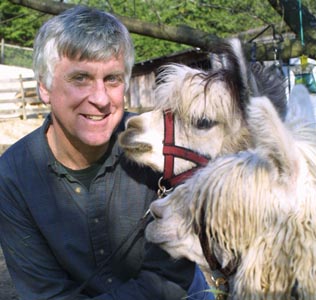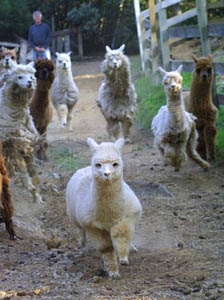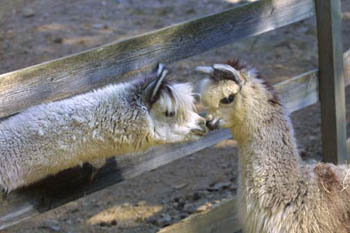![[MetroActive Features]](/features/gifs/feat468.gif)
[ Features Index | Santa Cruz Week | MetroActive Central | Archives ]
Alpaca My Bags: Eric Hoffman says Ziggy (front) and McDuff represent the best and the brightest of the camelid species.
The Emperor of Alpacas
Eric Hoffman discovered the golden fleece--and no, it isn't itchy
By Tai Moses
ON A RAINY DAY in 1976, Eric Hoffman met a llama that changed his life. He was visiting friends in Northern California who lived near a llama farm, and he walked over to check it out.
A llama came up to the fence and looked at him with, as Hoffman would later describe it, "the quiet resolve that is purely llama." On impulse, Hoffman shelled out $700 and bought the llama, whose name was Sunny.
Eric and two buddies took Sunny backpacking in the Sierra--the first time a pack llama had ever been in the national park system. They climbed the summit of Mt. Whitney and trekked 110 miles across the Sierra (Sunny carried all the gear). Hoffman wrote an article about the expedition titled "Sunny, the Pioneer Llama." It was published in California Living, the former magazine of the San Francisco Chronicle, and it launched his career as a writer.
Eight years and many llamas later, serendipity again smiled upon Hoffman in animal form. He was hosting the International Llama Conference at the Cocoanut Grove. Some importers had brought an exotic animal into the United States, a smaller, woollier cousin of the llama native to the Andes of Peru, Chile and Bolivia.
"They unloaded them here, and as soon as I saw them, I knew this is where I wanted to go. This is it: I'm there."
Eric Hoffman had been smitten by an alpaca--the llama's better angel.
Today, the descendants of those first intrepid South American immigrants graze the gently sloping acreage behind Hoffman's home in Bonny Doon, site of the only alpaca farm in Santa Cruz County. Hoffman, now 54, has become an alpaca breeder and an internationally recognized authority on alpacas and llamas as well as their wild camelid cousins, vicuñas and guanacos. "What's odd," he reflects, "is that meeting Sunny kicked off two things--this whole animal world, and the writing thing took off too."
Meet the Alpacas
A GROUP OF young male alpacas gazes at a visitor quizzically, alfalfa straw poking out the corners of their rubbery lips and clinging to their shaggy coats. They are droll, gentle, curious creatures who look as if they have sprung fully realized from the imagination of Dr. Seuss.
About half the size of a llama, alpacas are covered in copious amounts of thick fleece. They have two-toed feet with soft pads, floppy topknots and enormous eyes fringed by long lashes.
Alpacas are utterly absurd and they are also positively beautiful. It is this unlikely combination, more than their practical use as wool bearers, that makes them so enchanting. "I just find them endearing," Hoffman says. "I like the way they interact. They're very communicative animals."
Hoffman's alpacas don't seem to mind that, instead of grazing the alta plano, the high, empty plains of the Andes, they are living the easy life in rural 95060. They don't mind much, in fact, as long as they have each other.
A solitary alpaca is a anxious alpaca. These camelids are herd animals that believe religiously in the idea of security in numbers. No alpaca ever gets a wild hair and decides to run away from home. No alpaca ever yearns to spend a night alone meditating on a mountaintop. An alpaca, even in a fit of pique, will stay close to its buddies.
In his memoirs, British actor Sir Alec Guinness recalled his first sight of a herd of alpacas. "They look lovely and not as daunting as llamas. I want one for my birthday, but I fear the idea will be frowned on. Only as a pet, of course, and perhaps as a pullover."
Their fluffy appearance does suggest a penchant for cuddliness, but they are actually rather reserved. "They don't fawn on you like a dog," Eric says. "They're basically sort of wild, but they go along with whatever you're trying to get done."
What he's trying to get done right now is to single out one alpaca from the herd. He eyes the yearlings, who in turn eye him back. They don't seem disturbed; just quietly and penetratingly observant, like Zen masters. "Maybe we should grab some of these guys," Hoffman suggests.
He approaches them with arms spread wide, as if encircling them with an invisible fence. There is no whooping or whistling in alpaca wrangling; such crude techniques would only insult the intelligence and subtlety of alpaca nature.
The yearlings move quickly away en masse, with the harmonious symmetry of a school of fish. An aerial view would show a large carpet of fluff, moving gracefully this way then that. On padded feet, they are almost noiseless. This schooling behavior, he explains, is called a "banding instinct. In the alta plano, there's no cover; the only thing they have to hide behind is each other."
He gently grabs a yearling, and everyone else dashes to one end of the paddock and turns as a single alpacan body to regard Hoffman with wide, astonished eyes. Actually, the audience has grown; every single alpaca in the adjoining corrals has lined up at the fence and is watching the show with rapt attention, like spectators at a rodeo.
The yearling knows the game is up and submits peacefully. These alpacas are mild-mannered chaps; they are not fighters. They don't bite or butt; they have no horns, hooves or incisors. Hoffman parts the yearling's thick silvery gray fleece to reveal a silky undercoat, a dense, soft, odorless abundance of luxuriant, lustrous wool.
Photograph by George Sakkestad
Getting Fleeced
IN THE mid-'90s, a team of archeologists discovered the mummified remains of a young woman, victim of a human sacrifice to the Inca gods, high in the Peruvian Andes. Her body was wrapped in an intricately patterned weaving made of alpaca wool.
The weaving, its colors still vivid, was in virtually perfect condition after being frozen, buried for some 500 years and unearthed in the melting ice. It looked, said one of the archeologists, "as if it were made yesterday."
That legendary durability has made alpaca a prized luxury fiber among artisanal weavers and knitters, and European fashion designers. Garments made from alpaca are five times warmer than sheep's wool, water-resistant, and come in a palette of natural earth tones from black to white and everything in between, including fawn, russet and silver.
"Various Andean cultures over a period of about 6,000 years created an animal with 22 natural colors," Hoffman explains, "which is a phenomenal feat in terms of genetic projects."
But, are they itchy?
To settle the question once and for all, Hoffman presents two sweaters--one in a multicolored geometric pattern, the other a silver-fawn shade he calls rose gray. "This," he says proudly, proffering the rose-gray sweater, "is McDuff." A touch confirms that the finely spun wool is feathery light and even softer than cashmere.
McDuff--who may soon put his stamp on a whole line of McDuffwear--is one of Hoffman's alpaca studs. He shares a corral with another stud, Ziggy. McDuff is a huacaya alpaca, with fluffy, crimped fiber that grows outward into a voluminous puffball. Ziggy is a suri, a much more rare type of alpaca. Only 10 percent of the world's alpacas are suris. A suri's fleece is supersoft; it has no crimp but spirals off their body in fine ropy ringlets that resemble dreadlocks.
Like many professional gigolos, Ziggy and McDuff have rather high opinions of themselves. A handful of grass offered to Ziggy elicits a piercing screech from McDuff that sounds like a loose fan belt. In response, Ziggy begins to spit at the back of McDuff's head. Scandalized by this breech of alpaca etiquette, McDuff enthusiastically returns the spit.
"It's a cantankerous relationship," Eric observes tactfully. "Ziggy is a very dominating animal. He's a nice guy in a lot of ways, but he doesn't know how to back off."
Unlike some other crabbier camelids, alpacas seldom spit at humans. "Spitting is a last resort," Hoffman says. "They'll telegraph what they want to do first."
Stand next to an alpaca for any length of time, and you may hear it hum--a creaky, soothing, kazoolike murmur. Humming is one of the more common alpaca vocalizations. They hum to themselves, and they hum to each other.
"The mothers and babies hum back and forth; it's a bonding thing. And they make an alarm call that sounds like a loud quacking; they also 'orgle' when they're breeding, which is sort of like"--here Hoffman emits a squishy rumble that sounds like a seal clearing its throat.
Alpacas, Accidentally
HOFFMAN'S RUSTIC, light-filled house, which he built back in the early '70s when land in Santa Cruz County was cheap and plentiful, is filled with weavings, paintings, pottery and baskets from his 40 or so trips to the Andes.
Today the camelid expert is wearing a brown fleece, made not from alpacas, but by Patagonia. Stuck to his sleeve are a few flakes of alfalfa hay. He pads about the house in soft leather scuffs, and his thatch of silver-gray hair is rumpled. He is shaggy and inquisitive and ruminative, not unlike his extended alpaca family.
Lately, Hoffman has been greeting visitors with the dreamy, preoccupied expression of a writer immersed in a project. He is updating the third edition of his reference work, The Alpaca Book, "the bible for alpaca breeders." Come July, however, he's off to Chile, where he'll screen alpacas for a DNA-based registry much like the Alpaca Registry he created here in 1988, which contains the genealogy, blood types and ownership records of nearly every one of the 30,000 alpacas now in the United States.
"The reason I wrote it was so llamas wouldn't be bred with alpacas, since marketers will sometimes breed a cheaper animal with a more expensive [one]. What I was trying to do was preserve the genetic qualities of the alpaca. The U.S. now has the largest population of alpacas in the world that can't be crossbred."
Alpaca breeders in Britain, Australia and New Zealand have copied his registry, and he occasionally gets requests to create registries for other animals; for instance, a rare French donkey called the Baudet du Poitou. Like most of the four-legged creatures dear to Eric's heart, the Poitou is something of an oddball. "It's a monster of an animal; it's as big as a huge draft horse and weighs 1,400 pounds. It's a superhairy donkey with ears 22 inches long."
Fleece Season: Alpacas are smaller and a little shier than llamas; they have gentle personalities; their fleece is softer than cashmere; they eat less than horses; and their padded feet don't tear up pastures.
Pullovers to Pronking
HOFFMAN LIKES to let the alpacas out to forage in the open area between their corrals. As he unlatches the gate, the herd begins to trot slowly toward him. When one moves, the others follow as if drawn by magnets. It's like the night of the living alpacas.
The clan tucks into the tall green grass with the fanaticism of true grazers. "They're good eaters," he says admiringly, as his herd rips mouthfuls of grass. "Happy campers."
Like many long-domesticated animals, alpacas have some remarkably humanlike traits. For example, they have faces. A gallery of a hundred alpaca portraits would reveal a hundred different alpaca faces. And any alpaca owner will tell you that alpacas are true characters, with preferences, eccentricities and distinctive personalities all their own, both contrary and sweet.
So it seems natural and right that Eric talks about his alpacas with the affectionate familiarity usually reserved for close friends and family members. They are his people. At the moment, he's thoughtfully probing the psyches of several of the crias, which is what baby alpacas are called.
"Mauricio's always insecure, so is William. You never see William away from his mother--his idea of life is to stay right on top of Mom." Sure enough, William, a little white suri, and his mother stroll around, nose to tail like circus elephants.
"What's funny is these other ones will play and interact, but I've never seen William step out on his own." Eric watches William for a moment and shakes his head. "That guy needs a psychiatrist."
"Then look at Annie, who half the time can't figure out who her mother is." Annie, an adorable white cria, is boldly going where no alpaca has gone before. "Annie's an interesting little animal, she's very independent. You hardly ever see her with her mother."
"That one, Alice, is eating like a horse," he observes, which is a funny thing to say since it would take 10 alpacas to eat as much as a horse. "She's just like a vacuum cleaner. She's a funny animal. She's a Peruvian import, and most of them are very standoffish--she's very bold. My guess is some Indian kids befriended her. She's just not fearful."
"I always like how they segregate themselves by age," he adds. Most of the crias have congregated a short distance away from the boring grown-ups. Without warning, Annie suddenly springs vertically into the air, demonstrating the astounding four-legged alpaca hop known as "pronking." Pronking is how a happy, healthy cria expresses herself.
"They do it near the end of the day," says Hoffman. "The babies start to play, and one of them will pronk through the group to pick up any more playful people, and somebody else will follow and eventually you get a whole line of animals all pronking together.
"The other day, they were all lined up and racing around and coming down the hill pronking at 100 miles an hour."
This gives him an idea.
"Hey kids, you want to go up the hill?"
The alpacas raise their heads, clumps of grass clinging to their short, velvety muzzles. Eric spreads his arms to deploy the invisible fence and shoos his people up to the top of the hill.
As the herd thunders back down the hill, nostrils wide, padded feet thrumming on the hardened earth, several crias spring into the air, twisting their heads and arching their backs in joyous pronking--a spontaneous performance that really has nothing to do with locomotion and everything to do with the exuberance of being alive and being an alpaca.
Copyright © Metro Publishing Inc. Maintained by Boulevards New Media.
![]()

Photograph by George Sakkestad
 The Running of the Wools: Surefooted and graceful, alpacas are light on their feet and quiet--even during one of their favorite recreations, running downhill at full speed.
The Running of the Wools: Surefooted and graceful, alpacas are light on their feet and quiet--even during one of their favorite recreations, running downhill at full speed.

Photograph by George Sakkestad
From the May 2-9, 2001 issue of Metro Santa Cruz.